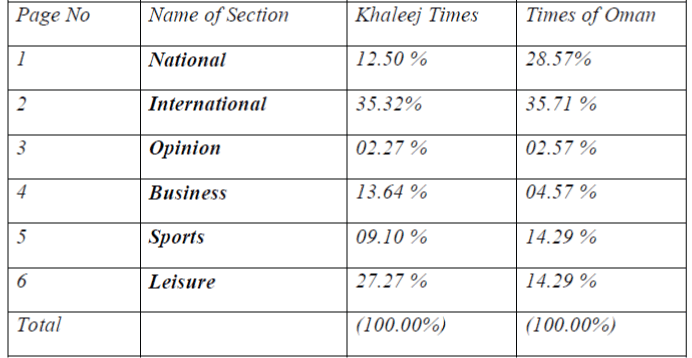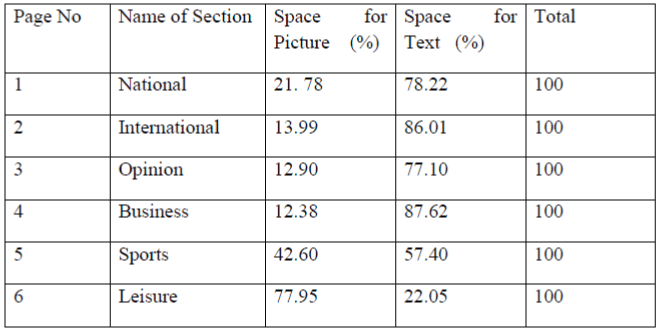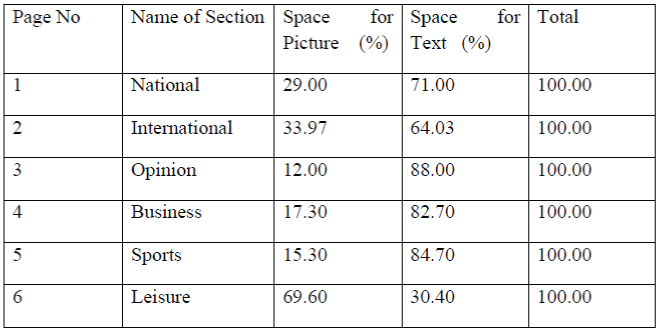ISSN: 1550-7521
ISSN: 1550-7521
Department of Communication Studies Sur College of Applied Science Ministry of Higher Education Sultanate of Oman
Visit for more related articles at Global Media Journal
The present paper is an attempt to analyse the content of Print Media (Ratio of Visuals and Text) in two important Middle East countries i.e. United Arab Emirates and the Sultanate of Oman. The main objective of the study is to identify the ratio of the space devoted to visuals (pictures, graphics etc) and texts (words) by the Print Media (National English Dailies) in UAE and Oman. In the Era of Globalization, Print Media is facing a threat from the electronic media. As in today’s world nobody has time to spend on reading the texts, readers want to get more information, through visuals, in less time. To counter this threat, Print Media is using more and more visual, to attract their audience. A comparative approach of content analysis is applied for the purpose of study. Data are collected mainly from primary sources. Secondary sources are also used. Critical media analysis is useful for media educators, students of media studies; authorities in the local government and policy makers of the large multinational companies.
Print Media, Audience, Visuals, Text etc.
‘A Comparative Study of Print Media in Oman and UAE’
Communication is an integral part of human civilization and culture. Mass media is a tool of communication with the society. The function of Media is to cater to us news and views. In performing these functions, Media is influenced and shaped by the culture and economics of the society. Thus, media is viewed as the mirror of the society in which they are operating.
In pluralist societies like UAE and Oman, media acts as a window to and mirror of society, which reflects different aspects of contemporary culture, economics, and politics and its influence on society.
There is a saying in media that ‘a picture is worth one thousand words’. The present study tries to analyze the proportion of the space devoted to pictures (visuals) and text in the print media.
With the growing influence of Electronic Media (especially TV), Print Media is facing threat to its audiences. The increase in number of TV audiences is being seen as decline in the newspaper audience.
The primary objective of the study is to identify the ratio of the space devoted to visuals (pictures, graphics etc) and texts (words) by the Print Media (National English Dailies) in Oman and UAE’.
Other objectives of this study are to:
1. Divide the print media into different sections (e.g. National, International, Opinion, Business, Sports, and Leisure etc.)
2. To find out the space devoted to each of these different sections
3. To identify the ratio of space devoted to text and picture in each of these different sections
4. To analyze and compare the results of the study
Some facts about Oman and UAE
United Arab Emirates and the Sultanate of Oman are two important countries of the middle-east region. In the past, the economies of these countries were mainly based on oil revenue. But now –a-days, they are diversifying it to other sources mainly on Tourism.
With the years of sustained efforts in the direction of diversification of revenue resources and promotion of tourism industry, a lot of investment is done in these countries. The result of which is that the many multinational companies have started their business operations in these countries and numbers of expatriate population have increased rapidly (total population of UAE is 4,444011, out of which UAE native population is only 20%, according to July 2007 est. based on a result of 2005 census)*, while population of Oman is 3,204,897 including 577,293 expatriates, according to July 2007 est**.
If we go through the above-mentioned figures, we find that a major chunk of the populace belongs to the expatriates. These expatriates come from the different countries, different geographies, and speak different languages. They follow different religions and follow different cultures, and traditions.
They all need to know what is happening and around them in the world. For their information need have to they depend upon mass media, which includes Newspapers, Magazines, TV, Radio, Internet etc. Newspapers (National Dailies) play a crucial role in fulfilling their information needs. It is generally assumed that the expatriates depend upon English Newspapers to satisfy their needs about information, as English has now become a global language for communication.
Media in UAE***
There are dozens of publications available in UAE, including dailies and weeklies. Some of them are mentioned below:
The press
• Al-Bayan- Dubai-based Arabic daily
• Gulf News- Dubai-based, English-language
• Khaleej Times- Dubai-based daily, English-language
• Emirates Business 24/7- English-language daily
• The National- Abu Dhabi-based English-language daily
Television
• Dubai Media Incorporated (DMI)- pan-Arab broadcaster, operates Dubai TV, Dubai One
• Abu Dhabi TV- pan-Arab broadcaster
• Ajman TV
• Sharjah TV
• MBC- Dubai-based pan-Arab broadcaster
• Al Arabia- news channel operated by MBC
Radio
• Abu Dhabi Radio
• Radio Asia commercial, broadcasts in Hindi, Urdu and Malayalam
• Ras al Khaimah Radio
• Al Arabiya FM- commercial, Arabic pop
• Dubai 92- commercial, English-language pop
• Noor Dubai 93.9- commercial, "Islamic-oriented" news, talk
• City 1016- commercial, programmes in English and Urdu
News Agency
• Emirates News Agency (WAM)
There are dozens of publications available in Oman, including dailies and weeklies. Some of them are mentioned below:
• Al Watan- Arabic-language daily
• Al Shabiba - Arabic-language daily
• Oman Daily- Arabic-language daily
• Oman Daily Observer- English-language daily
• Times of Oman- English-language daily
• Oman Tribune - English-language daily
Television
• Oman TV- state-run
Radio
• Radio Oman- state-run, operates Arabic and English-language networks
• Hala FM - private, Arabic music
• Al Wisal - private, Arabic music
• Hi FM - private, English-language
News Agency
• Oman News agency
A quantitative research approach is adopted for the purpose of study. Collected data are analysed using the percentile method. Gathered data are comparatively analysed to get the desired results.
The present study tries to focus on daily editorial content (news and views) of the print media. It does not take into account the advertisements and information sections (TV programme guide, flight timings, currency exchange rates etc) for the purpose of study.
The above-mentioned study covers two leading English daily newspapers from The Sultanate of Oman and The United Arab Emirates. The Times of Oman daily English Newspaper represents The Sultanate of Oman, while Khaleej Times represents The United Arab Emirates for the purpose of the above-mentioned study.
The newspapers of past one month (common period for both the newspapers) were analysed for the purpose of study.
The data for the present study were drawn from the primary sources.
These primary data were obtained from the newspapers of past one month. The time period is same for both the newspapers selected for the purpose of study
Judgmental sampling method is used for the purpose of this study. Two different English news dailies were selected (one each from the United Arab Emirates and the Sultanate of Oman).
A sample of one month’s newspapers is used for the purpose of study. The newspapers of same time period (from 1st September to 30th September 2008) were used to conduct the study.
The Times of Oman English daily newspaper represents the Sultanate of Oman, while Khaleej Times represents the United Arab Emirates for the purpose of the above-mentioned study.
There are four main English news dailies operating in the UAE. These are Gulf News, Khaleej Times, Emirates Business 24/7, and the National and in three major English news dailies operating in the Sultanate of Oman. These are Oman Tribune, Oman Daily Observer and the Times of Oman.
The newspapers selected for the purpose of study have strong presence in the market. Both the newspapers selected for the study have over three decades of publishing and printing expertise. The Times of Oman English daily newspaper representing the Sultanate of Oman was established in the year 1975, while Khaleej Times representing the United Arab Emirates was started in 1978.
The Times of Oman is being published from the Muscat, the capital of the Sultanate of Oman.
Khaleej Times is being published from Dubai, the Business Capital of the United Arab Emirates.
Both the newspapers selected for the study are among the oldest publication in their respective countries.
This study has two major limitations:-
1. This study does not take into account the advertisements (any kinds of advertisements) for the purpose of analyzing the media
2. This study takes into account only the daily news / view items for analyzing the media. It does not consider the weekly sections (magazines / pull-outs) for the purpose of study.
The study is conducted in five steps. These are:
1. Dividing the entire Print Media is into six (06) different sections these are: National, International, Opinion, Sports, Business and Leisure.
2. Measuring the space devoted to each of the above sections.
3. Identifying the space devoted to visuals and Text in each of these sections
4. Calculating the ratio of space devoted to visuals and text in each of these sections and arriving at an average for the total period of study.
5. Analyzing and comparing the results from the study
Research Findings
Space occupied by different sections (percent wise):

After analysing the above data following interpretation can be obtained:
1. Both the media organizations have devoted maximum space to the International section-which caters the international news to the audience.
2. Both the media houses have devoted minimum space to opinion section.
3. With the Khaleej Times, national news gets forth place; while with the Times of Oman, national news gets second place.
4. Leisure section gets second place with Khaleej Times, while with Times of Oman, it gets 3rd place.
Devoting maximum space to International section shows that the English audience have greater interest in the international news.
Devoting least space for opinion section shows that there is a dearth of serious readers, as opinion section is considered as a serious reading section in the newspapers.
Ratio of Picture and Text in the Khaleej Times

After analysing these data following results can be concluded:
1. The Leisure section gets the maximum visuals (77.95%).
2. Business section gets the minimum visuals (12.38%).
3. Sports section gets the second highest visuals (42.60%).
4. National section stands at forth place in terms of visuals (21.78%).
It shows that people read the leisure section for light / entertainment mood. There is the least text in the leisure section. This is one section which competes with TV (main function of which is providing entertainment). The audience want to get maximum information with least efforts of reading the text.
Opinion pages are generally considered for serious reading material. For serious reading they are not provided with more visuals.
Ratio of Picture and Text in the Times of Oman

After analysing these data we find following results:
1. The Leisure section gets the maximum visuals (69.60%).
2. Opinion section gets the minimum visuals (12.00%).
3. International section gets the second place (33.97%).
4. National section stands at fourth place (29.00%).
It shows that people read the leisure section for light / entertainment mood. There is the least text in the leisure section. This is one section which competes with TV (main function of which is providing entertainment). The audiences want to get maximum information with least efforts of reading the text.
Opinion pages are generally considered for serious reading material. For serious reading they are not provided with more visuals.
1. Leisure Section: Maximum visuals
In both the newspapers leisure section get the maximum space for visuals.
In Khaleej Times it is 77.95% visuals and 22.05% text, while in Times of Oman, space for visual is 69.60% and for text it is 30.40%.
2. Opinion Section: Minimum / second minimum visuals
In Khaleej Times it is 12.90% visuals (second minimum) and 87.10% text, while in Times of Oman it is 12.00% visuals (minimum) and 88.00% text.
3. National Section: In both the newspapers National section gets 3rd place in terms of visuals.
In Times of Oman space for visuals is 29.00% and for text is 71.00%, while in Khaleej Times space for visuals is 21.78% and for text it is 78.22%.
4. International Section: In Times of Oman space allocated for visuals is 33.97% (2nd place) and for text is 64.03%, while in Khaleej Times space for visuals is 13.99% 4th place) and for text it is 86.01%.
5. Business Section: In Times of Oman space allocated for visuals is 29.00% (4th place) and for text is 71.00%, while in Khaleej Times space for visuals is 21.78% (last place) and for text it is 78.22%.
6. Sports Section: In Times of Oman space for visuals is 15.30% (5th place) and for text is 84.70%, while in Khaleej Times space for visuals is 42.60% (2nd place) and for text it is 57.40%.
Print media have literate audiences. This fact determines the nature of relationship between the press and its audience. The press try to cater to the specific needs of its audience.
This study confirms the assumption that people read the leisure pages for leisurely / relaxing mood. Leisurely pages are considered to provide light reading material, free of too much text, with lots of picture (as a picture is worth one thousand (1000) words). Audiences don’t want to read more when it comes to Leisure /entertainment. So the leisure section caters them with lots of visuals and less text.
Opinion pages provide serious views and detailed analysis of the news events. Readers want to get the detailed stuff for reading. So, the readers are provided with the less visuals and more text.
Sports pages are also considered entertainment pages, yet in this regard we find a contrast in both the papers. Khaleej Times allocates 2nd maximum space for visuals, while Times of Oman allocates 5th place for visuals.
Business pages have a mixed variety of audiences. So, different newspapers allocate different proportion of space for visuals. In the Times of Oman, it is 4th place, while in Khaleej Times it is last place (6th).
Interestingly, the TV audiences are increasing by leaps and bounds. Still newspapers are trying to keep audience by providing a good/ balance mix of entertainment and information.
If the newspapers incorporate more and more visuals, they would be able to attract their audience. The sports section is one such area for Times of Oman where more visuals are required, as this section find audience everywhere in the world. Media Studies is a relatively new discipline in the field of Education. In UAE and Oman, media studies are still in their nascent stages. There is not much research done in this area.
* 2008 CIA World Fact Book ** Worldpress.org ***BBC.com
Definition of Key Words:
Print Media: Print media means the newspapers, magazines, journals, books, pamphlets, leaflets and any other printed materials etc.
For the purpose of study, Print Media means the English Daily Newspapers
Audience: Audience means the consumers and users (viewers, listeners, readers etc) of different types of media.
For the purpose of study, audience means the readers of Print Media.
Visuals: For the purpose of study visuals means the pictures, graphics, animations, special colour effects etc used with the text of Print Media.
Texts: For the purpose of study texts means the written or printed words used in the print media.
Division of newspapers in different sections
The two Newspapers selected for study are broadly divided into six sections.
1. National: It consists of the pages (including front page and last page) which carry the national news.
2. International: It consists of the pages which carry the international / global news.
3. Opinion: It consists of the pages which carry the editorials / personal views by columnists etc (not the news).
4. Sports: It consists of the pages which carry the sports related news.
5. Business: It consists of the pages which carry the business & economic news.
6. Leisure: It consists of the pages which carry leisurely / light reading material.
Copyright © 2025 Global Media Journal, All Rights Reserved